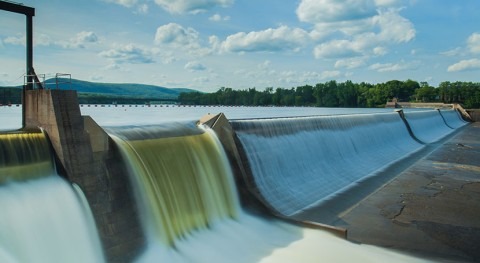The deluge that surged through Central Texas over the Fourth of July weekend devastated the hill country and shocked the world with its intensity and loss of life.
The Guadalupe River at Kerrville rose from 1.73 feet to 34.29 feet in three hours on July 4, according to a river gauge maintained by the federal government.
The floodwaters have killed at least 108 people, including 27 campers and counselors from the all-girls Camp Mystic near Kerrville, with five campers and one counselor still missing.
We need to drastically improve the current methods for precipitation nowcasting and flash floods. Solutions may come from the best available physics and data-driven tools including but not limited to AI
“The rainfall rate was extremely high, in some places reaching more than four inches per hour,” says Samuel Munoz, an associate professor of marine and environmental sciences at Northeastern University.
“When the rainfall is that intense, the ground cannot absorb the water, so water flows quickly to streams and rivers,” he says.
As extraordinary as it is to have months’ worth of rainfall in hours, scientists say to expect more flash flooding in the future as warmer water and air temperatures lead to increased precipitation from hurricanes and other storms.
What happened in ‘flash flood alley’
The hill country in Central Texas where the Guadalupe River overflowed its banks is known as “flash flood alley” due to its susceptibility to flooding.
One factor is the area’s soil, which is hard-packed, dry and shallow with little organic matter, says Peter “James” Dennedy-Frank, Northeastern assistant professor of marine and environmental sciences with an expertise in hydrology.
What happens when it rains is known as “infiltration of excess overland flow,” he says.
“The idea is that the soil can’t soak up the water as fast as it’s coming in. The water runs off really fast into the river channels. So you can have these floods that come up in an hour or two,” Dennedy-Frank says. “During intense storms, you have a lot of surface runoff happening really fast.”
“The rate of rise on this was really amazing,” Dennedy-Frank says, adding that he had never before witnessed waters rise 30 feet in three hours or 20 feet in an hour.
In addition to the intensity of the rainfall, the location — on both branches of the Guadalupe River — supercharged the flooding, he says. “We’re getting all that accumulation from the whole watershed area rather than just a portion of the watershed area,” he adds.
Further setting the stage for tragedy was the timing, when the area teemed with recreational campers celebrating the July 4 weekend.
How AI can make better predictions
Although the National Weather Service issued flood warnings the night of July 3 and the morning of July 4, the rapid intensification of the flash flood caught officials by surprise.
“We need to drastically improve the current methods for precipitation nowcasting and flash floods,” says Auroop Ganguly, Northeastern distinguished professor of civil and environmental engineering.
He says solutions may come from the best available physics and data-driven tools including but not limited to AI.
“I would say the current numerical weather prediction models, despite significant progress over the last few decades, may have reached their limit with respect to heavy regional precipitation potentially leading to flash floods,” Ganguly says.
“Our advanced warning and communication systems, especially in risk-prone areas, may need an overhaul. There is a need for holistic solutions in this era of intensification of extreme precipitation,” he says.
Take a look at the Waverly flood that swamped part of Tennessee in 2021, he says. Meteorologists predicted 2 to 3 inches of rain, but 21 inches fell that day in August, killing 20 people.
In the wake of that disaster, Ganguly’s then Ph.D. student Puja Das got a grant from NASA to work with the Tennessee Valley Authority (TVA), as well as with the NASA and SDS Lab inspired startup Zeus AI, on better forecasting models.
She took a recently developed hybrid model that incorporates traditional physics with data generated by AI, and made it trustworthy by incorporating metrics relevant for river managers, Ganguly says.
“This work was published recently in a journal and is now being tested on the TVA’s operational system,” he says.
“One thing AI can do is take a look at large data sets that we did not have before and try to find patterns from those data,” Ganguly says.
””Using information learned from a huge amount of data in space and time, combined with physics that is relatively well understood, may be more effective in predicting the kind of short-term, intense rainfalls that cause floods and flash floods,” he says.
The other deadly Texas flash flood
The death toll and the loss of so many young lives from the Guadalupe River flooding that killed at least 30 children have riveted the world’s attention.
But it wasn’t the first deadly flash flood in Texas this summer.
Less than a month ago, flash floods swept 15 vehicles into a creek in San Antonio. Thirteen people died. The victims ranged in age from their 20s to their 60s.
Better forecasts of flash floods also require improved understanding of the flow of water on the ground surface and in rivers, says Dennedy-Frank, who has a joint appointment in civil and environmental engineering.
Munoz says it’s important to provide training for the next generation of meteorologists and hydrologists. “These positions are as essential as firefighters, police, teachers, doctors and nurses to national security and prosperity, and should be treated as such,” he says.
Relief, rescue and recovery are the immediate focus in the aftermath of the Texas floods, Ganguly says. “Lessons must be learned eventually from each disaster in terms of preparedness, adaptation, and mitigation.”













